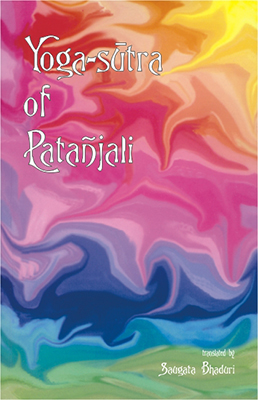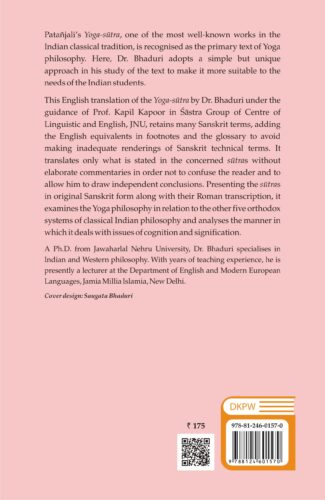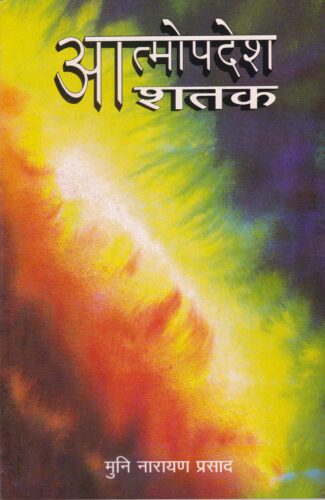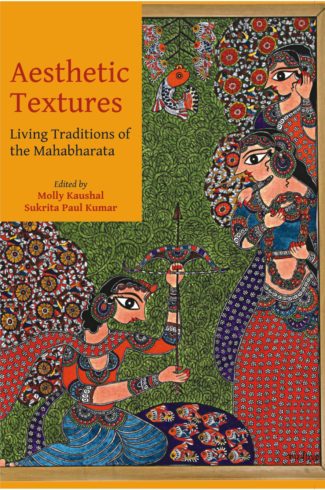

Yoga-Sutra of Patanj...
Yoga-Sutra of Patanjali
by: Saugata BhaduriThe English translation of Yoga-sutra adopts a unique approach: it retains many Sanskrit technical terms to present their inadequate rendering in English and avoids elaborate commentaries. It examines Yoga philosophy in relation to other orthodox philosophical system and analyses issues of cognition and signification.
$20.00
ISBN: 9788124601570
Year Of Publication: 2006
Edition: 2nd
Pages : xv, 86
Bibliographic Details : Glossary; Index
Language : English
Binding : Paperback
Publisher: D.K. Printworld Pvt. Ltd.
Size: 22 cm.
Weight: 150
Patanjali’s Yoga-sutra, one of the most well-known works in the Indian classical tradition, is recognised as the primary text of Yoga philosophy. Here, Dr. Bhaduri adopts a simple but unique approach in his study of the text to make it more suitable to the needs of the Indian students. This English translation of the Yoga-sutra by Dr. Bhaduri under the guidance of Prof. Kapil Kapoor in shastra Group of Centre of Liguistic and English, at Jawaharlal Nehru University, retains many Sanskrit terms, adding the English equivalents in footnotes and the glossary to avoid making inadequate renderings of Sanskrit technical terms. It translates only what is stated in the concerned sutras without elaborate commentaries in order not to confuse the reader and to allow him to draw independent conclusions. Presenting the sutras in original Sanskrit form along with their Roman transcription, it examines the Yoga philosophy in relation to the other five orthodox systems of classical Indian philosophy and analyses the manner in which it deals with issues of cognition and signification.
Foreword
The Shastra Group at Jawaharala Nehru University — An Introduction
— Kapil Kapoor
Introduction
1. Six Indian Philosophical Systems and Patanjalis Yoga-Sutras
Indian Philosophical Systems
Purpose and Nature of Philosophical Inquiry: Overcoming Suffering
The Different Systems — Ontology and Epistemology
Mimamsa and Vedanta
Nyaya and Vaisheshika
Samkhya and Yoga
Yoga
The Answers to the Question — How to Get Rid of Suffering Here and Now
This translation of Yoga-Sutras
2. The Yoga-sutra-s
Book One: Samadhipada (On Concentration)
Goal of Concentration (I.1-4) — Types of Vritti-s (I.5-11) — Means for the Nirodha of Vritti-s (I.12-16) — Types of Yoga (I.17-20) — Degrees of Samadhi (I.21-2) — Discussion on Ishvara (I.23-8) — Antarayas and Their Accompaniments (I.29-34) — Suitable Objects for Abhyasa (I.35-9) — Power of the Yogi (I.40) — Samapatti and its Types (I. 41-4) — Two Types of Samadhi (I.45-51)
Book Two: Sadhanapada (On Means of Attainment)
Kriya-Yoga (II.1) — Types of Klesha and Means for their Weakening (II.2-11) — On Karma (II.12-14) — On Duhkha (II.15-24) — On Kaivalya (II.25-7) — The Eight Anga-s of Yoga (II.28-55)
Book Three: Vibhutipada (On the Powers Attained)
The Remaining Three Anga-s (III. 1-3) — Samyama as Leading to Nirbija Samadhi (III.4-10) — Parinama and its Samyama (III.11-16) — Other Samyama-s and Powers Attained Therefrom (III. 17-52) — Culmination of Samadhi in Kaivalya (III.53-5)
Book Four: Kaivalyapada (On Isolation)
Substances and Vasana (IV. 1-13) — Cognition of Vastu and the Citi (IV. 14-23) — Kaivalya as the Ultimate Realisation of Purusha (IV. 24-34)
Appendix: Cognition and Signification in the Yoga System of Philosophy
Glossary and Index






